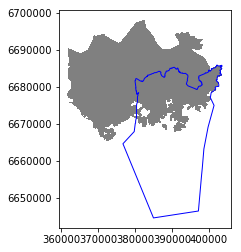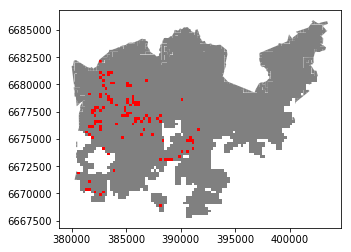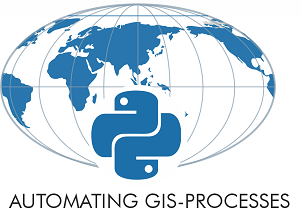Geometric operations¶
Overlay analysis¶
In this tutorial, the aim is to make an overlay analysis where we create a new layer based on geometries from a dataset that intersect with geometries of another layer. As our test case, we will select Polygon grid cells from TravelTimes_to_5975375_RailwayStation_Helsinki.geojson that intersects with municipality borders of Helsinki found in Helsinki_borders.shp.
Typical overlay operations are (source: QGIS docs):

Let’s first read the data and take a look how they look:
import geopandas as gpd
import matplotlib.pyplot as plt
import shapely.speedups
%matplotlib inline
# Let's enable speedups to make queries faster
shapely.speedups.enable()
# File paths
border_fp = "data/Helsinki_borders.shp"
grid_fp = "data/TravelTimes_to_5975375_RailwayStation.shp"
# Read files
grid = gpd.read_file(grid_fp)
hel = gpd.read_file(border_fp)
# Plot the layers
ax = grid.plot(facecolor='gray')
hel.plot(ax=ax, facecolor='None', edgecolor='blue')
<matplotlib.axes._subplots.AxesSubplot at 0x2637d634cc0>

Here the blue area is the borders that we want to use for conducting the overlay analysis and select the geometries from the Polygon grid.
Always, when conducting GIS operations involving multiple layers, it is required to check that the CRS of the layers match:
# Ensure that the CRS matches, if not raise an AssertionError
assert hel.crs == grid.crs, "CRS differs between layers!"
Indeed, they do. Hence, the pre-requisite to conduct spatial operations between the layers is fullfilled (also the map we plotted indicated this).
Let’s do an overlay analysis and create a new layer from polygons of the grid that
intersectwith our Helsinki layer. We can use a function calledoverlay()to conduct the overlay analysis that takes as an input 1) the GeoDataFrame where the selection is taken, 2) the GeoDataFrame used for making the selection, and 3) parameterhowthat can be used to control how the overlay analysis is conducted (possible values are'intersection','union','symmetric_difference','difference', and'identity'):
intersection = gpd.overlay(grid, hel, how='intersection')
Let’s plot our data and see what we have:
intersection.plot(color="b")
<matplotlib.axes._subplots.AxesSubplot at 0x2637d5e9128>

As a result, we now have only those grid cells that intersect with the Helsinki borders. As we can see the grid cells are clipped based on the boundary.
Whatabout the data attributes? Let’s see what we have:
print(intersection.head())
car_m_d car_m_t car_r_d car_r_t from_id pt_m_d pt_m_t pt_m_tt \
94 29476 41 29483 46 5876274 29990 76 95
95 29456 41 29462 46 5876275 29866 74 95
96 36772 50 36778 56 5876278 33541 116 137
97 36898 49 36904 56 5876279 33720 119 141
193 29411 40 29418 44 5878128 29944 75 95
pt_r_d pt_r_t pt_r_tt to_id walk_d walk_t GML_ID NAMEFIN \
94 24984 77 99 5975375 25532 365 27517366 Helsinki
95 24860 75 93 5975375 25408 363 27517366 Helsinki
96 44265 130 146 5975375 31110 444 27517366 Helsinki
97 44444 132 155 5975375 31289 447 27517366 Helsinki
193 24938 76 99 5975375 25486 364 27517366 Helsinki
NAMESWE NATCODE geometry
94 Helsingfors 091 POLYGON ((402250.0001322526 6685750.000039577,...
95 Helsingfors 091 POLYGON ((402367.8898583531 6685750.000039573,...
96 Helsingfors 091 POLYGON ((403250.000132058 6685750.000039549, ...
97 Helsingfors 091 POLYGON ((403456.4840652301 6685750.000039542,...
193 Helsingfors 091 POLYGON ((402000.0001323065 6685500.000039622,...
As we can see, due to the overlay analysis, the dataset contains the attributes from both input layers.
Let’s save our result grid as a GeoJSON file that is commonly used file format nowadays for storing spatial data.
# Output filepath
outfp = "data/TravelTimes_to_5975375_RailwayStation_Helsinki.geojson"
# Use GeoJSON driver
intersection.to_file(outfp, driver="GeoJSON")
There are many more examples for different types of overlay analysis in Geopandas documentation where you can go and learn more.
Aggregating data¶
Aggregating data can also be useful sometimes. What we mean by aggregation is that we basically merge Geometries into together by some common identifier. Suppose we are interested in studying continents, but we only have country-level data like the country dataset. By aggregation we would convert this into a continent-level dataset.
In this tutorial, we will aggregate our travel time data by car travel times (column car_r_t), i.e. the grid cells that have the same travel time to Railway Station will be merged together.
For doing the aggregation we will use a function called
dissolve()that takes as input the column that will be used for conducting the aggregation:
# Conduct the aggregation
dissolved = intersection.dissolve(by="car_r_t")
# What did we get
print(dissolved.head())
geometry car_m_d car_m_t \
car_r_t
-1 (POLYGON ((388000.0001354803 6668750.0000429, ... -1 -1
0 POLYGON ((386000.0001357812 6672000.000042388,... 0 0
7 POLYGON ((386250.0001357396 6671750.000042424,... 1051 7
8 (POLYGON ((386250.0001357467 6671500.000042468... 1286 8
9 (POLYGON ((387000.0001355996 6671500.000042449... 1871 9
car_r_d from_id pt_m_d pt_m_t pt_m_tt pt_r_d pt_r_t pt_r_tt \
car_r_t
-1 -1 5913094 -1 -1 -1 -1 -1 -1
0 0 5975375 0 0 0 0 0 0
7 1051 5973739 617 5 6 617 5 6
8 1286 5973736 706 10 10 706 10 10
9 1871 5970457 1384 11 13 1394 11 12
to_id walk_d walk_t GML_ID NAMEFIN NAMESWE NATCODE
car_r_t
-1 -1 -1 -1 27517366 Helsinki Helsingfors 091
0 5975375 0 0 27517366 Helsinki Helsingfors 091
7 5975375 448 6 27517366 Helsinki Helsingfors 091
8 5975375 706 10 27517366 Helsinki Helsingfors 091
9 5975375 1249 18 27517366 Helsinki Helsingfors 091
Let’s compare the number of cells in the layers before and after the aggregation:
print('Rows in original intersection GeoDataFrame:', len(intersection))
print('Rows in dissolved layer:', len(dissolved))
Rows in original intersection GeoDataFrame: 3826
Rows in dissolved layer: 51
Indeed the number of rows in our data has decreased and the Polygons were merged together.
What actually happened here? Let’s take a closer look.
Let’s see what columns we have now in our GeoDataFrame:
print(dissolved.columns)
Index(['geometry', 'car_m_d', 'car_m_t', 'car_r_d', 'from_id', 'pt_m_d',
'pt_m_t', 'pt_m_tt', 'pt_r_d', 'pt_r_t', 'pt_r_tt', 'to_id', 'walk_d',
'walk_t', 'GML_ID', 'NAMEFIN', 'NAMESWE', 'NATCODE'],
dtype='object')
As we can see, the column that we used for conducting the aggregation (car_r_t) can not be found from the columns list anymore. What happened to it?
Let’s take a look at the indices of our GeoDataFrame:
print(dissolved.index)
Int64Index([-1, 0, 7, 8, 9, 10, 11, 12, 13, 14, 15, 16, 17, 18, 19, 20, 21,
22, 23, 24, 25, 26, 27, 28, 29, 30, 31, 32, 33, 34, 35, 36, 37, 38,
39, 40, 41, 42, 43, 44, 45, 46, 47, 48, 49, 50, 51, 52, 53, 54,
56],
dtype='int64', name='car_r_t')
Aha! Well now we understand where our column went. It is now used as index in our dissolved GeoDataFrame.
Now, we can for example select only such geometries from the layer that are for example exactly 15 minutes away from the Helsinki Railway Station:
# Select only geometries that are within 15 minutes away
sel_15min = dissolved.iloc[15]
# See the data type
print(type(sel_15min))
# See the data
print(sel_15min.head())
<class 'pandas.core.series.Series'>
geometry (POLYGON ((388250.0001354316 6668750.000042891...
car_m_d 12035
car_m_t 18
car_r_d 11997
from_id 5903886
Name: 20, dtype: object
As we can see, as a result, we have now a Pandas Series object containing basically one row from our original aggregated GeoDataFrame.
Let’s finally convert the
Seriesinto GeoDataFrame and plot it to see where those 15 minute grid cells are located:
# Create a GeoDataFrame
geo = gpd.GeoDataFrame([sel_15min.values], crs=dissolved.crs, columns=dissolved.columns)
# Plot the grid cells that are 15 minutes a way from the Railway Station
ax = dissolved.plot(facecolor='gray')
geo.plot(ax=ax, facecolor='red')
<matplotlib.axes._subplots.AxesSubplot at 0x2637dbafc18>

Simplifying geometries¶
Sometimes it might be useful to be able to simplify geometries. This could be something to consider for example when you have very detailed spatial features that cover the whole world. If you make a map that covers the whole world, it is unnecessary to have really detailed geometries because it is simply impossible to see those small details from your map. Furthermore, it takes a long time to actually render a large quantity of features into a map. Here, we will see how it is possible to simplify geometric features in Python.
As an example we will use data representing the Amazon river in South America, and simplify it’s geometries.
Let’s first read the data and see how the river looks like:
import geopandas as gpd
import pycrs
# File path
fp = "data/Amazon_river.shp"
data = gpd.read_file(fp)
# Print crs
print(data.crs)
# Plot the river
data.plot();
{'proj': 'merc', 'lon_0': -43, 'lat_ts': -2, 'x_0': 5000000, 'y_0': 10000000, 'ellps': 'GRS80', 'units': 'm', 'no_defs': True}

The LineString that is presented here is quite detailed, so let’s see how we can generalize them a bit. As we can see from the coordinate reference system, the data is projected in a metric system using Mercator projection based on SIRGAS datum.
Generalization can be done easily by using a Shapely function called
.simplify(). Thetoleranceparameter can be used to adjusts how much geometries should be generalized. The tolerance value is tied to the coordinate system of the geometries. Hence, the value we pass here is 20 000 meters (20 kilometers).
# Generalize geometry
data['geom_gen'] = data.simplify(tolerance=20000)
# Set geometry to be our new simlified geometry
data = data.set_geometry('geom_gen')
# Plot
data.plot()
<matplotlib.axes._subplots.AxesSubplot at 0x2637f725390>

Nice! As a result, now we have simplified our LineString quite significantly as we can see from the map.
